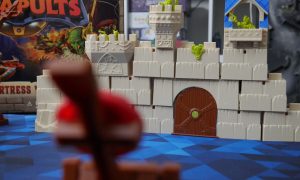Back In 1957, the USSR launched the Sputnik 2 into orbit. This was no surprise as it was when the space race was heating up, but the intriguing part was who exactly was the passenger of the world’s first man-made satellite. Laika, a stray dog from the streets of Moscow was chosen at random to attempt the feat of being the first animal to orbit the Earth. While her mission was mostly a success, she died of overheating hours after launch.
Enter The Sun at Night, a wonderfully named game that tells the story of Laika in an alternate form, instead of dying, she finds herself marooned on a planet and rescued by soldiers opposing the Soviet Union. In her crash landing, she also picked up some helpful little powers, such as the gift of speech and a blaster ray that never runs out of ammo. You take control of Laika as she attempts to help the forces that saved her. To do so, she must go about a quest to disrupt the plans of the people who created her. It’s a wildly unique setup that you will not see in any other video game.
Due to the premise and real history surrounding your main character, it is very easy to develop a large attachment to Laika. Reading up on her history (and also being a dog lover)only helps build upon that emotional connection. She is a fantastic main character, despite not having any particularly compelling lines of dialogue. It is very clear that developer Minicore loved the story behind Laika and wanted to bring her to life in a video game. That’s a large task to accomplish,and they did so elegantly.

Unfortunately, once you begin to take part in Laika’s story by controlling her throughout her adventure, the positives begin to fade away. While controlling Laika’s movement is far from an issue, using your blaster weapon while moving can feel like a frustrating mess due to the speed at which you are moving. The alternative to this would be to stop moving, which only results in you being showered with opposing bullets until you run into your untimely death. It only gets more unwieldy when you add in the shield to the equation.
Untimely deaths are something you will run into consistently in The Sun at Night due to its old school save system. It requires you to activate points throughout the map that you can save at, with no autosaves at your disposal. While this is not a game breaking issue, it definitely adds a layer of infuriation when you die randomly because you forgot to activate your shield. Also the health system is old-school, based around health packs instead of regenerative health. The Sun at Night does a great job at reminding us why more games use regenerative health. You consistently find yourself in situations where you have a sliver of health and practically no chance at living, sometimes right after hitting a save point.. It’s a great way to kill any kind of momentum the games tries to build.

Visually, The Sun at Night is an absolute joy to stare at. It features some fantastic art reminiscent of the era in which the game is set. Of course, you see the expected hammer and sickle but you also see some odd art featuring Joseph Stalin. Laika’s movement and the things taking place around you are all animated very nicely with a special flourish that few games can pull off. Unfortunately, there is one visual issue and that is with the cluttered map reminiscent of similar MetroidVania style games. It shows an outline of every room you have been in, but the rotating 3D angle makes you lose track of what anything on screen actually means. Using the map to navigate your surroundings is a bewildering experience that at times feels impossible. Thankfully, the actual visuals in-game are far from a mess.
The Sun at Night also features some fantastic audio design, done by video game audio contractor Gl33k (Halo 4, Orcs Must Die 2). The footsteps of Laika echo enjoyably (though that can turn infuriating after dying) and the weapons all pop with the strength you would hope. Most notably though is the music that pumps out of your speakers.The range of music can change throughout the experience but one thing is certain: the tunes will amp you up and prepare you for the action ahead. The electric pulses of sound that fly out at you surpass the generic soundtrack most smaller games feature and instead keep you constantly interested in what track you will hear next.
Avid video game lover who enjoys Tennessee Vol athletics more than one man should. I also listen to hip-hop whenever possible. I'm an odd fellow. Currently attending the great University of Tennessee. Avi by @DiceSMS

The Sun at Night is a wonderful idea that features a lovable main character with a very interesting past. Unfortunately, the gameplay does not feel like it is quite there yet, as its adherence to old-school design elements impairs player accessibility. There are tools built around the game, such as the bumping music, that could help it succeed but the issues hold back those positives from shining too bright. The potential for a fantastic product is there, but Minicore could not grasp that potential in the final version of The Sun at Night.
PROS
- Fantastic sound design and music
- Wonderful premise with great main character
CONS
- Frustrating map
- Outdated design elements hamper experience
- Frustrating deaths galore
See below for our list of partners and affiliates:























